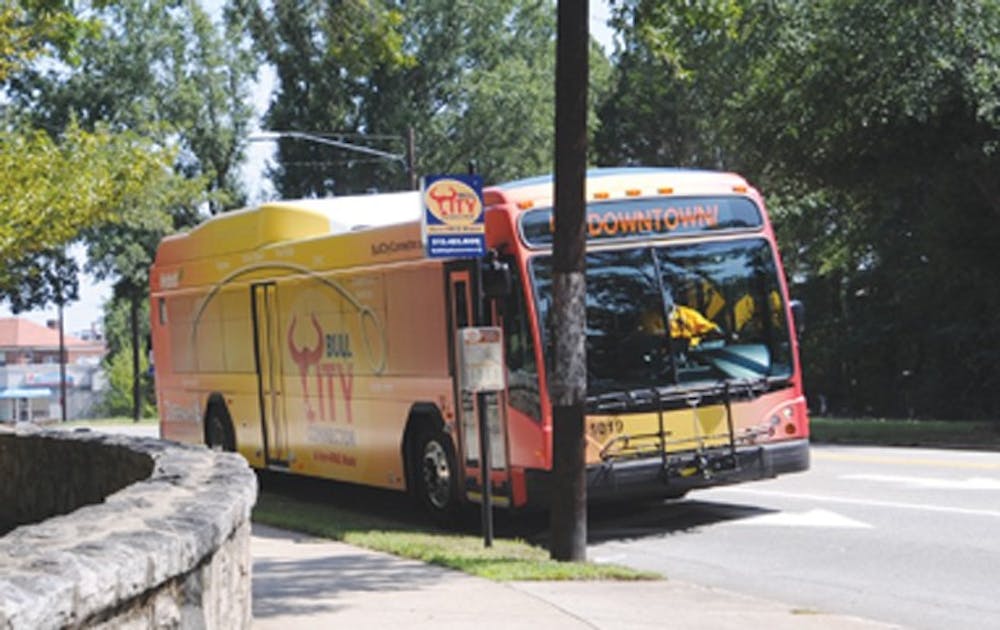Although Duke extended its two-year partnership with the Bull City Connector, low University rider rates are making administrators reevaluate the relationship.
Earlier this month, Duke contributed $350,000 to help subsidize the operation costs of the bus line through 2013. Although the University’s donation will cover 30 percent of the BCC’s operating costs for 2013, Duke is still assessing whether to continue to support the line into the future as it is unclear how many students and staff regularly use the bus.
The free bus service, which started Aug. 16, 2010—with the aid of federal grant money, vehicle registration fees and about $1 million from Duke. The service runs through downtown Durham to East Campus, West Campus and the Duke University Medical Center. Despite its initial contributions to the line, Duke is not sure if continued support is worth the cost.
“The student ridership is not what we have expected for the first two years,” Phail Wynn, vice president for Durham and regional affairs, said.
Duke Medical Center North is the most popular stop, but it is not clear how many of those riders are affiliated with the University, Wynn noted. The Connector was only outfitted with more accurate ridership monitoring equipment in April. The equipment calculates how many students and staff ride the BCC better than the previous systems, allowing the University to determine whether to continue past this third year.
“We hope to have a lot more students riding it, particularly going into the city past Ninth Street to get more engaged in the both commercial and civic aspects of the city,” Wynn said.
The low ridership is partially due to a lack of student awareness of the line, noted sophomore Derek Rhodes, vice president of Durham and regional affairs for Duke Student Government.
“It is fairly new, and I think that students are getting accustomed to it and figuring out what it is and what they can do with it,” Rhodes said. “Secondly, Duke students just don’t like to use public transportation.”
But he added that DSG is working hard to push more students to use the system.
Last year, DSG made a video called “How to Ride the Bull City Connector” to promote the service. The video shows current DSG President Alex Swain, a senior who previously held Rhodes’ position, giving a tour of the BCC route and the opportunities it offers to students in Durham, which include transport to internships, the Durham art walk and fine dining.
DSG is also trying to encourage more programs to utilize the line such as the Devils After Dark program for freshmen and other student groups on West Campus.
“Anytime that they are doing anything out in the community, we want to encourage them to use the Bull City Connector,” Rhodes said.
Many students, especially upperclassmen, might prefer to use their own cars to get into town, Rhodes noted. But riding the BCC saves students time and gas, he added.
One of the main goals of BCC was to reduce the carbon footprint of traffic through Durham and Duke because the diesel hybrid Connector buses would reduce the need for cars, especially for the 2,000 Duke employees living in downtown Durham.
“By this time next year we’ll have about 2,700 [employees],” Wynn said, “My hope was we’ll make it easier for employees to go back and forth without having to drive.”
But even if student use of the Connector picks up, the future of its partnership with Duke is uncertain because Main Street is slated to be closed for construction work on the bridge over Campus Drive shortly after commencement in May. As a result, the BCC and all the traffic on Main Street will be re-routed down Buchanan Boulevard and up Markham Avenue. The construction should only last a maximum of 150 days, said Mark Ahrendsen, director of the Durham Department of Transportation. But Wynn is concerned that during that time, the Connector may lose customers.
“Approximately 14,000 vehicles per day—during the week—travel down that strip of Main Street, which means that they will have to detour that many cars around East Campus,” Wynn said.
The Connector has been working towards maintaining a 15-minute headway—or wait time—between buses, Wynn said.
“But once they start detouring all these cars, that’s going to change these headways dramatically,” he said. “And my concern is that we’ll lose a lot of loyal riders because they’ll be sitting there having no idea how long it will take for the bus to get there.”
But Ahrendsen is optimistic about the partnership.
“We feel that it’s been a mutually beneficial project for both the city and the University and University hospital,” Ahrendsen said.
He added that the Connector currently meets and exceeds its goal of 2,000 daily riders, although there are still opportunities to increase ridership.
For now, however, the BCC remains one of the main ways to get to or from downtown Durham—especially for Blue Devils who do not own cars, such as freshman Noura von Briesen, who went to downtown for an Orientation Week event.
“We were at the [Durham Performing Arts Center] and we didn’t want to wait for the chartered bus to take us back to campus,” von Briesen said, so she and some friends rode the BCC back to East Campus.
Von Briesen said she is not sure if she will ride the BCC again soon.
“If it goes by someplace that I have to go, then sure—it’s free,” she said.
Get The Chronicle straight to your inbox
Signup for our weekly newsletter. Cancel at any time.

